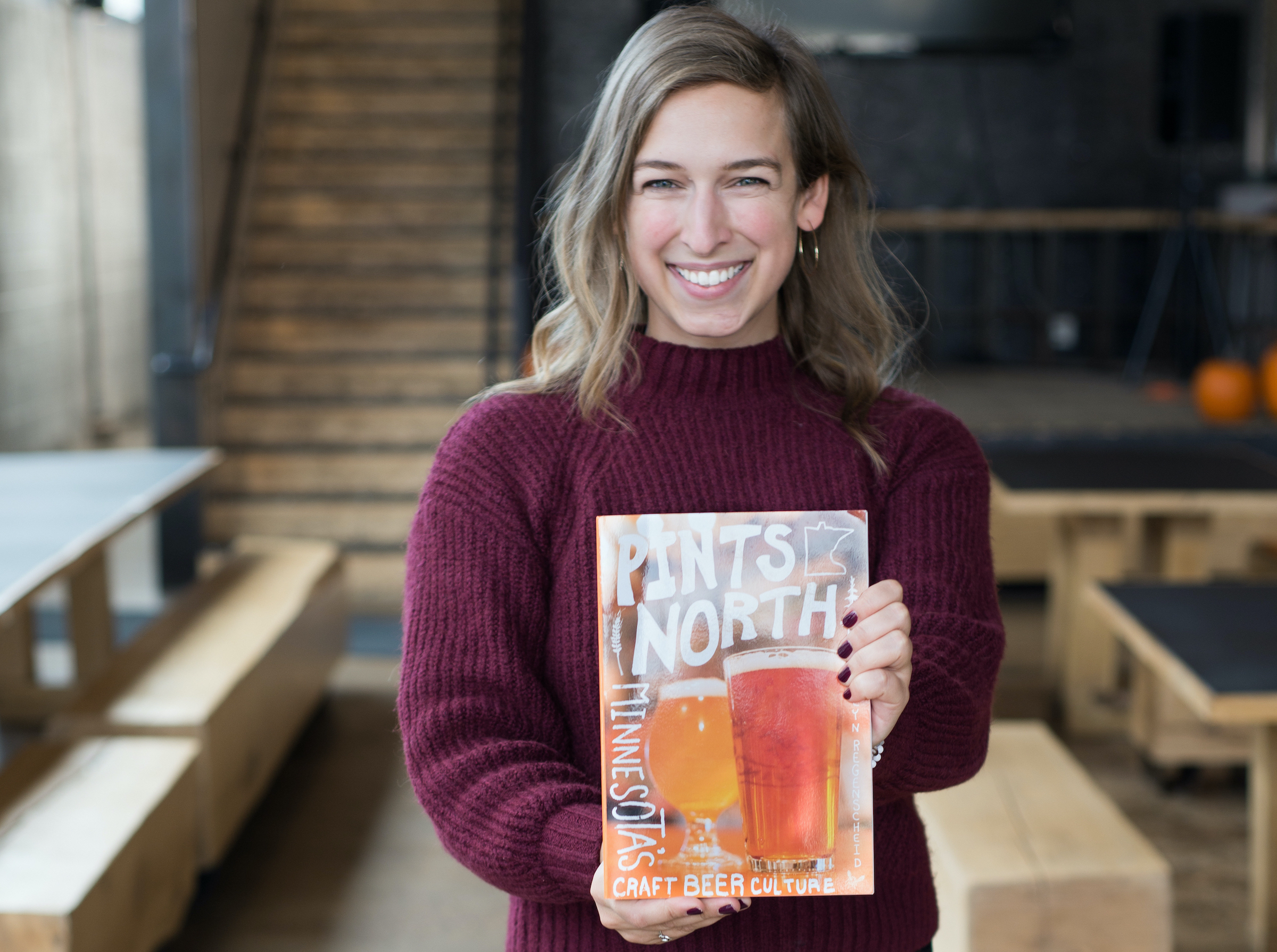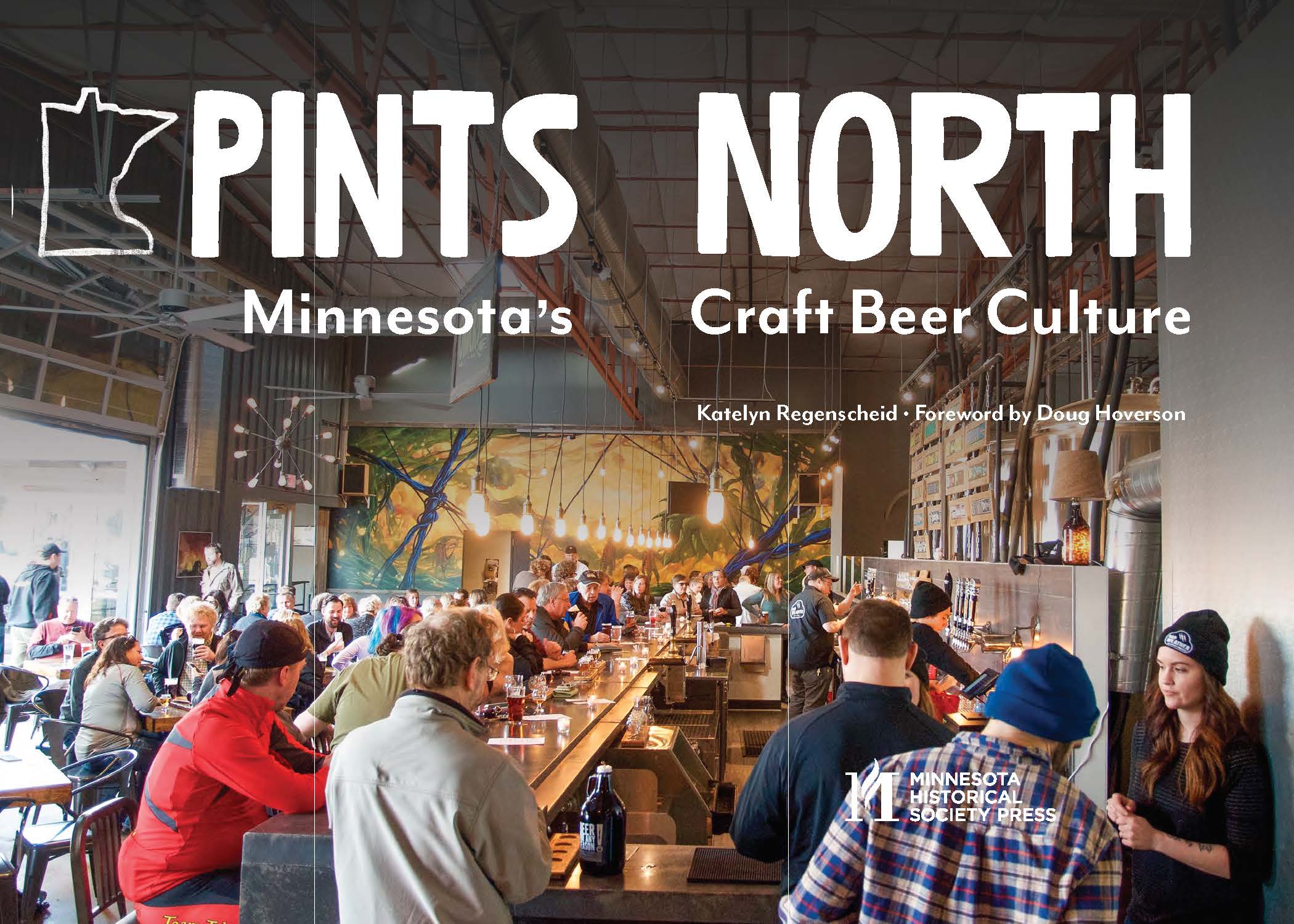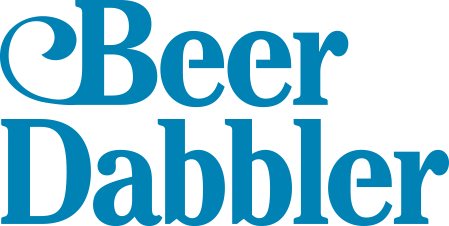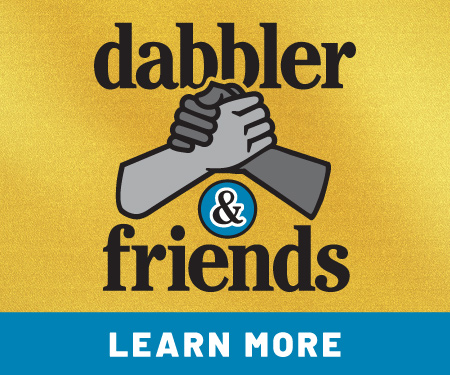
Katelyn Regenscheid, author of Pints North at the Inbound BrewCo taproom • Photo via Katelyn Regenscheid
In the heady beer boom times of 2016, writer and marketing professional Katelyn Regenscheid had just graduated college and was in need of a project to fill up her days and bridge the gap between academia and the so-called “real world.” Armed with a rapidly growing love of craft beer that she had developed during school, Regenscheid decided to visit every taproom in Minnesota and document the process on a blog she dubbed Beer and Life.
Four years and more than 150 taprooms later, Katelyn now serves as the marketing coordinator for Inbound BrewCo and still somehow found time to write a wonderful book about the modern history of the Minnesota beer scene called Pints North: Minnesota Craft Beer Culture. The book is available now via the Minnesota Historical Society Press and makes a great read for beer geeks and newbies alike.
We asked Katelyn to reflect on some of the challenges and joys of writing a craft beer book, her favorite local taprooms, and more.
Beer Dabbler: One of our favorite get-to-know-you questions in the beer world is, “What was your ‘gateway beer’ for craft beer?” so we were pleased to see that you shared that story in your book’s preface. What made that first pint so special?
Katelyn: My first craft beer was an Odell Treeshaker IPA at the Contented Cow pub in my college town. I consider myself immensely lucky that I came of age in a golden era for craft beer—a time when I could walk into the pub in a little river town and find something as fantastic as an Odell beer. In fact, I’ve never had to face the challenge of homebrewing just to get my hands on flavorful beer. And, even in college, macro beers and domestic lagers were reserved exclusively for keg parties and beer darts.
What really drew me to the Treeshaker IPA was a tasting note listed on the chalkboard menu, which is a feature that’s unique to craft beers, as compared to domestic macro beers. I think those flavor experiences have been a common thread throughout my experiences with craft beer: they regularly expand my palate and push me to explore new styles and ask more questions about the chemistry, innovation, or even longstanding culture behind different flavors.
You embarked on an ambitious journey to visit every brewery with a taproom in Minnesota back in 2016. That’s one hell of an undertaking, how did you manage to accomplish that, and looking back now, what did you learn about the soul of Minnesota beer from that journey?
Pints North definitely stemmed from my blog. I was a recent college graduate in search of a passion project. When I started, the task to visit every taproom in Minnesota seemed manageable, but breweries started opening faster than I could visit them. It’s no surprise that I completed my Minnesota taproom tour in the winter months, which is not a particularly popular time to open a brewery, so openings slowed down enough for me to catch up.
In the Twin Cities, it was fairly easy to convince a couple friends to join me every weekend and head out to a new taproom. Then, I structured my visits to outstate breweries to be a series of mini road trips, so I could hit four or so new breweries in a weekend without having to double back on a several-hour car ride. Oftentimes those road trips also involved camping overnight, which was easier, cheaper, and more fun than finding hotels. When I finally finished the blog by visiting every taproom, I started work on my book. Since then, a couple dozen more breweries have opened, and I am looking forward to picking my camera back up and heading out to visit them.
Visiting all these breweries, especially through the lens of the mini-interviews I conducted, gave me a special insight into the industry. Plus, with my camera in hand, I was pretty conspicuous, which easily sparked conversation. Folks would quickly open up to me and start telling me stories about the brewery, how it started, and the highlights of working there. I learned just how friendly and proud this industry is. It is really a crew of people—from all kinds of industries and backgrounds—who are proud to make something with their hands and serve it directly to an appreciative customer.
It sounds simple, but maybe that’s because it is. This industry is built to be connected: taprooms in Minnesota must be immediately adjacent to their brewery, which means you’re more likely to encounter a brewer or owner during your visit. Plus, more and more breweries are opening and operating as neighborhood pubs rather than functioning under the production and distribution model. This means they especially function as a neighborhood watering hole, often owned by someone in the community.

Katelyn and her trusty camera, back in the early days of her Beer and Life blog • Photo via Katelyn Regenscheid
Sorry to do this, but we’re going to ask you to play favorites now: During that journey, what was your favorite Twin Cities brewery that you visited, and what was your favorite outstate brewery?
This is always such a difficult question, because I love breweries not just for their beer, but also for the social experience of their taproom and the memories I made there. Part of me is tempted to pick different breweries every time I am asked this question just to spread the love.
I had a fantastic experience at Portage Brewing on my first visit there, and they are featured in the book as well. My first visit was a warm summer day, I was camping at a state park not far away, and the brewer/owner [Jeff Vondenkamp]’s mom poured my beer while she chatted me up about her son’s path to opening the brewery. It was this perfectly cozy, Minnesotan experience and it really warmed my heart. Plus their beer is fantastic.
In the suburbs, I have to give a shoutout to HammerHeart, who is also featured in the book. On my first visit, my palate was nowhere near ready for their smoked beers. But return visits over the years really opened me up to the beer, and now I love it. The brewery is actually quite close to the Twin Cities, but it feels like its own world once you get there.
In the Twin Cities, I have the luxury of visiting different taprooms for specific beers, experiences, and proximity to other activities. But, if I had to pick one local business that I’m always going to support, I think that would be Fair State. Not only is their beer consistently great, but they also have a strong commitment to treating people well, and I think that is what this industry has the potential to stand for. Evan Sallee, one of their founders, speaks about this in the Fair State feature in my book. I also work for Inbound in Minneapolis and love to drink there because it’s almost like drinking in my living room with all my friends there.
A lot of the brewers in your book began as passionate amateurs who got their start homebrewing before going public and opening a brewery. Did getting your book published after years of blogging and freelance writing feel legitimizing in a similar way to you? What was that process like?
I do think seeing my name attached to a story in print was a good way to dip my toes in the water of beer writing. Writing shorter stories may have been like a test batch or a homebrew in this metaphor before investing in the “big thing.” But, I think I had the opportunity to learn directly from people who are smarter and more experienced than me, which isn’t always the case for brewers unless they go to brewing school or work as an apprentice or assistant before opening. Some people would say all brewers should work for someone else in the industry before starting their own operation, and I can’t imagine writing this book without getting education and encouragement from earlier editors and other writers.
I thought it was perfect that Doug Hoverson wrote the foreword to Pints North because, in many ways, your book feels like a spiritual sequel to his excellent Land of Amber Waters. What influence did Doug’s writing have on your own approach, and what was it like to see his foreword for the first time?
Doug’s book is a fantastic tome of Minnesota beer history, and I’m so glad he wrote it. He’s a historian by trade, and you see that come through in his research, photos, and writing. As I read through Doug’s account of Minnesota brewing history, I felt compelled to record today’s stories in real-time so some historian in 50 years could use my text to write another book like Doug’s.
I am also interested in diagnosing and analyzing the joy I feel as I am feeling it, which is why I wanted to capture Minnesota’s beer industry as it is right now. I think that made my book stylistically pretty different from Doug’s, which is good because I am not sure who could compete with him. So much has happened in Minnesota beer in the last 10 years, and there is no comprehensive accounting of those events. Local publications can be pieced together to paint a portion of a larger portrait, but I wanted to pair that recent information with interviews and images to record a broader account of Minnesota’s craft beer culture in the 21st century.
Doug helped me a lot throughout the publishing process, which I think is symbolic of what this industry is like, even for the people who write about it. He saw all my early drafts and talked me through new ideas and edits. Reading his foreword was an honor because he brought together our two somewhat different books in a high-level way. It’s still exciting to have my work associated with his.
Within Pints North you tell the story of Minnesota beer in the 21st century through the lens of 16 breweries. While there are some obvious must-haves in there like Schell’s, Summit, and Surly, we’re curious about how you chose the smaller or lesser-known breweries that you featured.
It was really tough to whittle down the list because every Minnesota brewery has its own story; even sharing images of their taprooms would be fantastic to document because they are all so unique. I tried to select breweries that both represented the whole of the industry but were also unique in their own ways. For example, I think Bang showcases the innovation and ethics of craft beer, Urban Growler offers an insight into food options while also touching on gender and LGBT representation, and Forager takes us outside the Twin Cities and allows me to touch on different business models and the laws that surround craft beer. Since I didn’t have enough pages to feature every brewery, I tried to tell stories that every brewery could see themselves reflected in.
In addition to covering beer as a writer, you’ve also been a member of the industry for years now as a marketing professional. What makes craft beer fascinating to you from a business perspective?
Craft beer is a production industry that sells straight to the consumer in a highly social setting. Not a lot of other businesses are like that—they either sell to a middle man or three before reaching the consumer, or they don’t get to interact with the consumer while they enjoy the product. The closest business model I can think of is the farmers market, where the consumer has the opportunity to purchase and enjoy the product of the seller’s hard labor—sampling a raspberry or a slice of cheese in front of the maker. So with craft beer, you have the joy of imbibing with your neighbors while also appreciating a locally made product, and odds are you can meet the maker in the process. I think some restaurants, and definitely craft distilleries and cideries, have this experience as well.
Your book goes into great detail to describe taprooms and the taproom experience as an integral part of a customer’s enjoyment of a brewery. What are some factors that you personally look for in a taproom?
I tend to favor openness in taprooms, but not at the cost of thoughtful design. I like communal seating and beautiful bartops. Aesthetics aside, I think taprooms are the most welcoming when they’re playing a low-key playlist under the hum of conversation.

Pints North‘s “spread page” • Photo via Katelyn Regenscheid
In your research for your book and your travels outside of this state, what are a few characteristics that set Minnesota’s beer scene apart from the rest of the Midwest, or the nation?
As far as my knowledge goes, each state has a slightly different maturity in its beer market. In places like Colorado, the craft beer market has been growing for a longer time, so you see more large regional breweries there. Here in Minnesota, we have a really robust market, but it’s a little younger, so we are heavily populated with smaller breweries that aren’t distributing far beyond state lines. The biggest difference though really comes from legislation: Minnesota is pretty archaic when it comes to liquor laws, which affects the size and shape of our market. That being said, I think breweries across state lines have a lot more in common than they do differences.
How much did COVID-19 affect your writing process for this book, and your overall outlook on the future of Minnesota craft beer? Are you hopeful, discouraged, or somewhere in between?
I was lucky to submit my final edits two months prior to the first COVID-19 shutdown in Minnesota. That means all of my interviews and most of my photos were taken care of before the restrictions kicked in. For the follow-up questions and additional photo requests, breweries did a great job of helping out while they were in the middle of a very scary time for their health and businesses.
To a degree, I am afraid for this industry. Everyone’s uncle has a quippy opinion to share on Facebook about how a business should be run and how a government should function, but I think the big picture is complicated and difficult to address. Most breweries worked hard to be safe places to socialize this summer and fall, and I think they did a good job and were able to get at least some money in the bank.
Unfortunately, the realities of this virus are making it near impossible to get the cashflow required to stay above water, and government relief packages are few and far between. I don’t claim to know much about brewery financing, but I think we can all see the writing on the wall. The impacts of COVID-19 are system-wide: selling Crowlers out the door is not enough for most breweries to account for lost sales in taprooms and at bars, can shortages are looming, and I don’t think the impetus should lie solely on the consumer to keep businesses afloat.
I don’t have a solution by any means, but I do know a few things: compassion and curiosity will get us further than quips; your bartenders miss pouring you a beer; you should look into what your elected representatives are doing to help small businesses; and your support has a strong positive effect on the industry’s morale.
In a post-pandemic world, what do you think the long-term future holds for Minnesota’s craft beer industry?
I am so hopeful for the return of a vibrant in-person craft beer scene in Minnesota. I am a firm believer in the social function of taprooms as a neighborhood community site—even those in the Twin Cities where we have a lot of choice. This pandemic has taught me to value those social interactions so much more than I ever did, and I think that’s the case for a lot of Minnesotans. My fingers are crossed that we also use reopening as an opportunity to rebuild a more diverse consumer base that better represents the makeup of our state. Craft beer is still painfully white, and I think we have a huge opportunity here, when we all crawl out of quarantine and a period of separation, to bring more of the community into these community spaces.




Leave A Comment